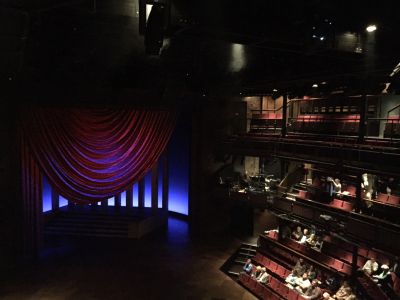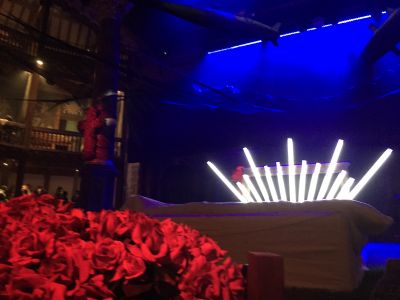On Tuesday and Thursday of this week we had the opportunity to see two very different interpretations of Shakespeare plays. On Tuesday, we went as a group to see Romeo and Juliet at the Globe. Some of us got there early enough to be at the front of the line for the groundlings – we ended up standing in the front row and were able to lean on the stage. This immediate closeness to the actors was a radically different theatrical experience than we had ever had. We were spit on by Mercutio, surprised by characters leaping out from under the stage, and sometimes even had to back up when the actors moved to the very front.
This closeness gave the brazenness of the interpretation some more subtlety and intimacy. The characters were in clownish makeup and gaudy costumes, red/black/white caricatures that were so exaggerated in their movements and speech that it was almost too alienating. However, the sightings of humanity in Romeo and Juliet, along with being close enough to see their every tear and tremble, brought a balance to the pseudo-farcical performance. There were many modern inclusions in the play, especially the musical choices (such as Village People’s “YMCA” and Dinah Washington’s “This Bitter Earth”) and occasional props (Romeo enters moodily wearing headphones and the “poison” is a gun).
Standing in the front row also included us directly in many of the breaking-the-fourth-wall moments. In the balcony scene, Romeo was moving through the audience with a stepladder, politely parting the groundlings. At one point, someone in our group jumped and gasped “Oh my God,” and Romeo stopped speaking and nodded and smiled at her, allowing time and space for us to laugh with him. Again, I’ve never experienced this sort of intimacy with an actor during a performance.
On Thursday, we took a day trip to Stratford-Upon-Avon. In the evening, we watched a performance of Antony and Cleopatra. This was a much more traditional performance, with everyone seating, conventional costumes and props, and little to no breaking of the fourth wall. It was also a play few of us had ever seen or read – I know for me (Helena), personally, it made me engage in a totally different way than Romeo and Juliet. I was more focused on the dialogue and plot than the details of the director’s decisions and the subtleties of the performance.
While much of the play was fairly traditional, the set design and changes were innovative. There was a platform in the middle of the stage that rose and sunk and which made the transitions between Rome and Egypt smooth and clear. There was a female vocalist who sang wordlessly throughout, giving the play a continuity even through change of place. It was a long performance – nearly 4 hours – but we appreciated being able to see different approaches to Shakespeare in two of the most significant theatres devoted to him.
Maddy and Helena
Note: On the left is Stratford and on the right is The Globe






